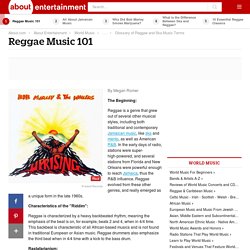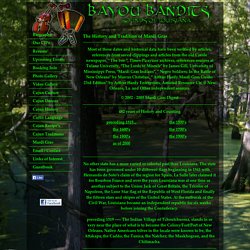

Reggae Music. By Megan Romer The Beginning: Reggae is a genre that grew out of several other musical styles, including both traditional and contemporary Jamaican music, like ska and mento, as well as American R&B.

In the early days of radio, stations were super-high-powered, and several stations from Florida and New Orleans were powerful enough to reach Jamaica, thus the R&B influence. Reggae evolved from these other genres, and really emerged as a unique form in the late 1960s. Characteristics of the "Riddim": Reggae is characterized by a heavy backbeated rhythm, meaning the emphasis of the beat is on, for example, beats 2 and 4, when in 4/4 time. Rastafarianism: Rastafarianism is a religion that is very common among Jamaicans of African descent. Continue reading below our video Popularity of Reggae in the United States: Bob Marley was reggae's best-known international ambassador. Marijuana and Reggae: Read More: Why Did Bob Marley Smoke Marijuana? Reggae Language: Reggae's Influence: Reggae Starter CDs: Native American Music. Salsa Music. Tex-Mex Music.
Tejano music or Tex-Mex music (Texan-Mexican music) is the name given to various forms of folk and popular music originating among the Mexican-American populations of Central and Southern Texas. With roots in the late 19th century, it became a music genre with a wider audience in the late 20th century thanks to artists such as Selena (often referred to as "The Queen of Tejano"), Mazz, La Mafia, La Sombra, Elida Reyna, Elsa García, Laura Canales, Oscar Estrada, Jay Perez, Emilio Navaira, Gary Hobbs, Shelly Lares, Stefani Montiel, David Lee Garza, Jennifer Peña, and La Fiebre. Origins[edit] Europeans from Germany (first during Spanish time and 1830s), Poland, and what is now the Czech Republic migrated to Texas and Mexico, bringing with them their style of music and dance. Cajun Music. Country and Western Music.
Country and western music, American popular music form originating in the Southeast (country music) and the Southwest and West (western music).

The two regional styles coalesced in the 1920s when recorded material became available in rural areas, and they were further consolidated after musicians from various sections met and mixed during service in World War II. The primary traditional difference between the two styles is that country music is simpler and uses fewer instruments, relying on guitar, fiddle, banjo, and harmonica, whereas the music of the Southwest tends toward steel guitars and big bands whose style verges on swing (e.g., The Light Crust Doughboys). Bluegrass, exemplified by Bill Monroe, is a style of country and western music traditionally distinguished by a driving, syncopated rhythm, high-pitched vocals, and an emphasis on the banjo, mandolin, and fiddle. See B. C. The Columbia Electronic Encyclopedia, 6th ed. Country Western Music. History of Cajun Music. Most of these dates and historical data have been verified by articles, references from saved clippings and articles from the old Creole newspaper, " The bee ", Times-Picayune archives, references sources at Tulane University, "The Lords of Misrule" by James Gill, University of Mississippi Press, "Mardi Gras Indians", " Negro Soldiers: In the Battle of New Orleans" by Marcus Christian, " Arthur Hardy Mardi Gras Guide: 23rd Edition" by Arthur Hardy Enterprises, Amistad Resource Ctr, @ New Orleans, La. and Other independent sources. © 2002 - 2005 Mardi Gras Digest 482 years of History and Counting No other state has a more varied or colorful past than Louisiana.

The state has been governed under 10 different flags beginning in 1541 with Hernando de Soto's claim of the region for Spain. Preceding 1519 ----- The Indian Village of Tchoutchuoma, stands in or very near the place of what is to become the Colony/Fort/Port of New Orleans. Return to top > 1715 ----- Louis Juchereau de St. Tex-Mex Music. Salsa music. Conga drums, one of the foundational instruments of salsa music. Salsa as a musical term[edit] "In 1973, I hosted the television show Salsa which was the first reference to this particular music as salsa. I was using [the term] salsa, but the music wasn't defined by that. The music was still defined as Latin music. And that was a very, very broad category, because it even includes mariachi music. But promotion certainly wasn't the only factor in the music's success, as Sanabria makes clear: "Musicians were busy creating the music but played no role in promoting the name salsa Globally, the term salsa has eclipsed the original names of the various Cuban musical genres it encompasses.
Issues of identity and ownership[edit] There is considerable controversy surrounding the term salsa and the idea that it is its own distinct genre. Reggae Music. Native American Music.